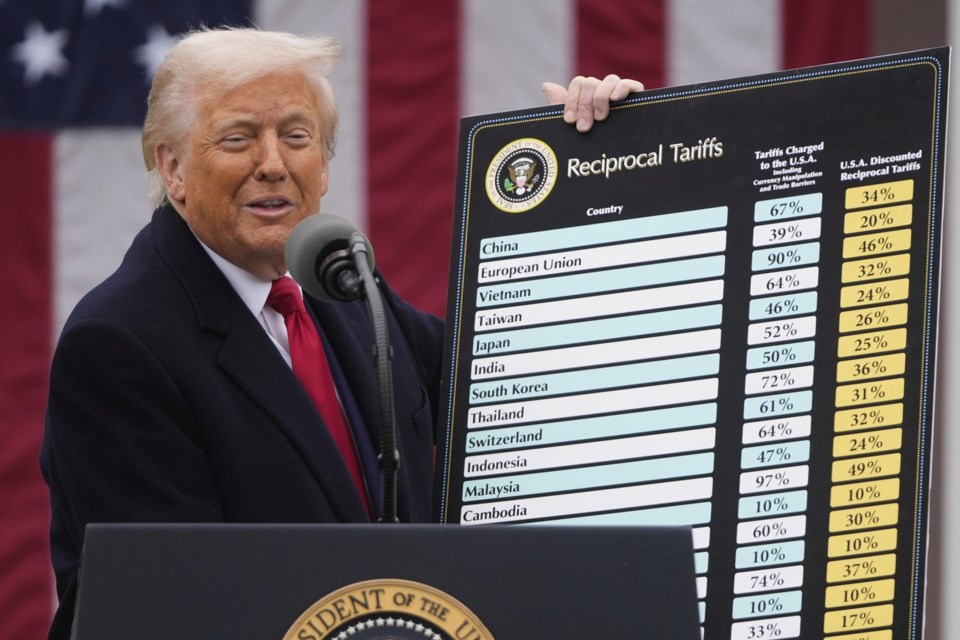NEW YORK (AP) — Just over three months ago, President Donald Trump — holding up large charts from the White House Rose Garden to outline new import taxes that the U.S. would soon slap on goods from nearly every country in the world.
But in line with much of Trump's on-again, off-again trade policy playbook, the bulk of those “Liberation Day” levies were postponed in April. The 90-day suspension arrived in an apparent effort to quell and facilitate country-by-country negotiations.
At that time, the administration set a lofty goal of reaching . Since then, however, the U.S. has only announced pacts with the United Kingdom and Vietnam — as well as a in a separate trade dispute. And the overall outlook for implementation has been murky. News of these deals often trickled through social media posts from the president and, even when countries on both sides of a negotiation table made more official announcements, many key details — including timing — were sparse.
The 90-day window was technically , but that deadline is now also getting an extension. On Monday, the U.S. began out letters to certain countries warning that higher could kick in Aug. 1 — not this week -- including to Japan and South Korea, which Trump said next month.
Even with negotiations ongoing, most countries have still faced a minimum 10% levy on goods entering the U.S. over the past three months, on top of punishing new taxes targeting as well as The current pause pushed back additional steeper rates, which Trump calls , for dozens of nations.
Here's what we know about the trade deals announced throughout the pause.
Vietnam
On July 2, Trump that he said would allow U.S. goods to enter the country duty-free. Vietnamese exports to the U.S., by contrast, would face a 20% levy.
That's less than half the 46% “reciprocal” rate Trump proposed for Vietnamese goods back in April. But in addition to the new 20% tariff rate, Trump said the U.S. would impose a 40% tax on “transshipping’’ — targeting goods from another country that stop in Vietnam on their way to the United States. Washington complains that Chinese goods have been dodging higher U.S. tariffs by transiting through Vietnam.
It wasn't immediately clear when these new rates would go into effect or whether they would come on top of any other previously-imposed levies. Like most other countries, Vietnam has faced Trump's 10% baseline tariff for the last three months.
United Kingdom
On May 8, Trump on British autos, steel and aluminum, among other trade pledges — while the U.K. promised to reduce levies on U.S. products like olive oil, wine and sports equipment. The deal was announced in grandiose terms by both countries, but for weeks.
When the deal was announced, for example, the British government notably said that the U.S. agreed to exempt the U.K. from its then-universal 25% duties on foreign steel and aluminum — which would have effectively allowed both metals from the country to come into the U.S. duty-free.
But the timing for when those cuts would actually take effect stayed up in the air for almost a month. It wasn’t until early June, when Trump to a punishing 50% worldwide, that the U.S. the agreement. And even then, U.S. tariffs on British steel and aluminum did not go to zero. The U.K. was the only country spared from Trump’s new 50% levies, but still faces 25% import taxes on the metals — and Trump said that rate could also go up on or after Wednesday.
The U.K. did not receive a higher “reciprocal” rate on April 2, but continues to face the 10% baseline tax.
China
At its peak, Trump’s new tariffs on Chinese goods totaled 145% — and China’s countertariffs on American products reached 125%. But on May 12, the countries agreed to their own 90-day truce to roll back those levies to 30% and 10%, respectively. And last month, details began trickling in about .
On June 11, following talks in London, Trump announced a “framework” for a deal. And late last month, the U.S. and China both acknowledged that U.S. Treasury Secretary Scott Bessent said that China had agreed to make it easier for American firms to acquire critical for manufacturing and microchip production. Meanwhile, without explicitly mentioning U.S. access to rare earths, the Chinese Commerce Ministry said that it would “review and approve eligible export applications for controlled items” and that the U.S. would “lift a series of restrictive measures it had imposed on China."
More specifics about those measures — and when they would actually go into effect — were not immediately clear. But on Friday, the Ministry of Commerce acknowledged that the U.S. was resuming exports of airplane parts, ethane and other items to China. And when Trump first announced the framework on June 11, the U.S. had said it agreed to stop seeking to revoke the visas of Chinese students on U.S. college campuses.
_________
Associated Press Staff Writers Josh Boak, Paul Wiseman and Fu Ting in Washington, D.C., Aniruddha Ghosal in Hanoi, and Huizhong Wu in Bangkok contributed to this report.
Wyatte Grantham-philips, The Associated Press



